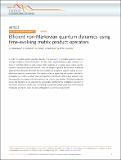Files in this item
Efficient non-Markovian quantum dynamics using time-evolving matrix product operators
Item metadata
| dc.contributor.author | Strathearn, Aidan | |
| dc.contributor.author | Kirton, Peter George | |
| dc.contributor.author | Kilda, Dainius | |
| dc.contributor.author | Keeling, Jonathan Mark James | |
| dc.contributor.author | Lovett, Brendon William | |
| dc.date.accessioned | 2018-08-20T10:30:10Z | |
| dc.date.available | 2018-08-20T10:30:10Z | |
| dc.date.issued | 2018-08-20 | |
| dc.identifier | 254670785 | |
| dc.identifier | 31210df2-2a3c-4d02-8d15-89fbb0ce6f89 | |
| dc.identifier | 85051939677 | |
| dc.identifier | 000442123200007 | |
| dc.identifier.citation | Strathearn , A , Kirton , P G , Kilda , D , Keeling , J M J & Lovett , B W 2018 , ' Efficient non-Markovian quantum dynamics using time-evolving matrix product operators ' , Nature Communications , vol. 9 , 3322 . https://doi.org/10.1038/s41467-018-05617-3 | en |
| dc.identifier.issn | 2041-1723 | |
| dc.identifier.other | ORCID: /0000-0002-4283-552X/work/47725846 | |
| dc.identifier.other | ORCID: /0000-0001-5142-9585/work/47725849 | |
| dc.identifier.uri | https://hdl.handle.net/10023/15844 | |
| dc.description | AS acknowledges a studentship from EPSRC (EP/L505079/1). PK acknowledges support from EPSRC (EP/M010910/1). DK acknowledges support from the EPSRC CM-CDT (EP/L015110/1). JK acknowledges support from EPSRC programs "TOPNES" (EP/I031014/1) and "Hybrid Polaritonics" (EP/M025330/1). BWL acknowledges support from EPSRC (EP/K025562/1). | en |
| dc.description.abstract | In order to model realistic quantum devices it is necessary to simulate quantum systems strongly coupled to their environment. To date, most understanding of open quantum systems is restricted either to weak system-bath couplings or to special cases where specific numerical techniques become effective. Here we present a general and yet exact numerical approach that efficiently describes the time evolution of a quantum system coupled to a non-Markovian harmonic environment. Our method relies on expressing the system state and its propagator as a matrix product state and operator, respectively, and using a singular value decomposition to compress the description of the state as time evolves. We demonstrate the power and flexibility of our approach by numerically identifying the localisation transition of the Ohmic spin-boson model, and considering a model with widely separated environmental timescales arising for a pair of spins embedded in a common environment. | |
| dc.format.extent | 9 | |
| dc.format.extent | 882981 | |
| dc.language.iso | eng | |
| dc.relation.ispartof | Nature Communications | en |
| dc.subject | QC Physics | en |
| dc.subject | DAS | en |
| dc.subject | BDC | en |
| dc.subject | R2C | en |
| dc.subject.lcc | QC | en |
| dc.title | Efficient non-Markovian quantum dynamics using time-evolving matrix product operators | en |
| dc.type | Journal article | en |
| dc.contributor.sponsor | EPSRC | en |
| dc.contributor.sponsor | EPSRC | en |
| dc.contributor.sponsor | EPSRC | en |
| dc.contributor.sponsor | EPSRC | en |
| dc.contributor.sponsor | EPSRC | en |
| dc.contributor.institution | University of St Andrews. School of Physics and Astronomy | en |
| dc.contributor.institution | University of St Andrews. Condensed Matter Physics | en |
| dc.identifier.doi | 10.1038/s41467-018-05617-3 | |
| dc.description.status | Peer reviewed | en |
| dc.identifier.grantnumber | EP/M010910/1 | en |
| dc.identifier.grantnumber | EP/L015110/1 | en |
| dc.identifier.grantnumber | EP/I031014/1 | en |
| dc.identifier.grantnumber | EP/M025330/1 | en |
| dc.identifier.grantnumber | en |
This item appears in the following Collection(s)
Items in the St Andrews Research Repository are protected by copyright, with all rights reserved, unless otherwise indicated.

